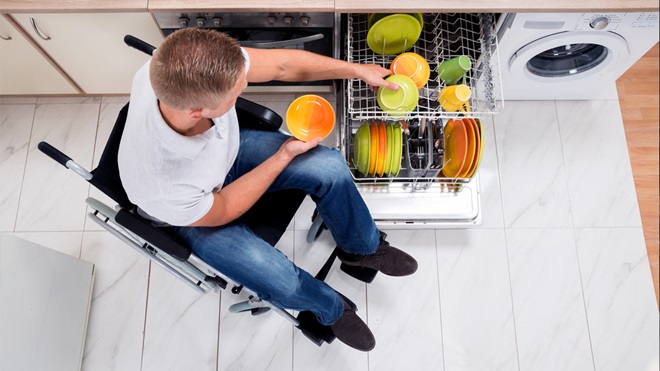If you have a disability, injury, back problems, arthritis, vision impairment or cognitive impairment, then washing dishes can be hard work - even if you've got a dishwasher to do it for you. We've based the following guidelines for choosing an accessible dishwasher on information from the Assistive Technology Australia.
If you're in a wheelchair or have back problems
There are a number of drawer, compact and benchtop dishwasher models on the market from a variety of manufacturers. These can help if you have issues bending down too far as they can be installed at chest height for a wheelchair user, or higher if you can stand up. Drawer and compact dishwashers are built in, bench-top models tend not to be. Most have smaller loading capacity due to their compact size. Alternately, if you have a bad back and you want a normal sized dishwasher, you can still get the plumber, or builder, to professionally install it at a higher height (maybe 50cm or so) so you don't need to bend over to load it. You might utilise the space below it for a deep drawer and the space above for a microwave.
- Drawer models, such as the Fisher & Paykel range, have pull-out drawers that contain the dishwasher compartment. These can also be installed in a two-drawer format called a double dishdrawer where you can activate only one drawer if necessary for a smaller wash.
- Compact models, such as those from Bosch, have a downward-opening door like an oven. The dishwasher stacking frame rolls out onto the door, as with a conventional dishwasher.
- Bench-top models, such as those from Omega and a number of other manufacturers, sit on top of a bench and also have a conventional door and loading system.
If you have an upper limb impairment
- Choose a model with a lightweight door and with a latch that's easy to open and close
- Look for controls that are easy to turn and press
- Check that baskets slide in and out easily
- Large, raised dials with a crossbar are good, but note that dials can be more difficult to use than buttons or keypads if you lack hand strength
- If hand strength is an issue, look for buttons and keypads that require only a soft touch to activate, and
- Make sure the filters can be easily removed, cleaned and replaced.
If you have a vision impairment
- You'll need controls that are easy to read – large, well-spaced and with good contrast, and well-labelled
- Positive feedback such as lights and/or beeps, and other tactile, audio and visual feedback is helpful, and
- Look for well-defined baskets – in a contrasting colour if available.
For people with cognitive or memory impairment
- An audible end-of-cycle signal and fault alarm can be helpful
- Look for labelling that's very clear
- Some people might find pictures or graphics more useful than words, and
- Choose appliances with few options for the controls.
Need more help? See our dishwasher buying guide for what you need to know before you hit the shops, and when you're ready to buy, check our dishwasher reviews to find the right model for you.
Stock images: Getty, unless otherwise stated.



